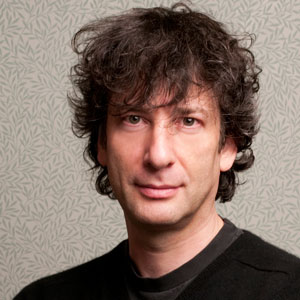 This lecture was presented as part of The Long Now Foundation’s monthly Seminars About Long-term Thinking.
This lecture was presented as part of The Long Now Foundation’s monthly Seminars About Long-term Thinking.
How Stories Last
Tuesday June 9, 02015 – San Francisco
Video is up on the Gaiman Seminar page.
*********************
Audio is up on the Gaiman Seminar page, or you can subscribe to our podcast.
*********************
How stories last – a summary by Stewart Brand
Stories are alive. The ones that last, Gaiman said, outcompete other stories by changing over time. They make it from medium to medium—from oral to written to film and beyond. They lose uninteresting elements but hold on to the most compelling bits or even add some. The most popular version of the Cinderella story (which may have originated long ago in China) has kept the gloriously unlikely glass slipper introduced by a careless French telling.
“Stories,” Gaiman said, “teach us how the world is put together and the rules of living in the world, and they come in an attractive enough package that we take pleasure from them and want to help them propagate.” Northwest coast native Americans have a tale about a beautiful woman and young man whose forbidden love was punished by the earth shaking, and black ash on snow, and finally fire coming from a mountain, killing many people. It stopped only when the beautiful woman was thrown into the burning mountain.
That is important information– solid-seeming mountains can suddenly erupt, and early warnings of that are earthquakes and ash. As pure information it won’t last beyond three generations. But add in beauty and forbidden love and tragic death, and the story will be told as long as people live in the mountains.
The first emperor of China died 2,300 years ago. He was so powerful that he was able to totally conceal the location of his tomb, and all that was left was stories about the fabulous treasures buried with him. There was said to a whole army of terracotta warriors and ships floating on lakes of mercury. A few years ago a terracotta warrior was dug up in a field in China, and then a whole army of them. Archaeologists figured out where the emperor’s mausoleum must be buried, but first they did something not normally done at archeological digs. They checked if there might be any incredibly poisonous mercury around. There is.
Gaiman said he learned something important about stories from his cousin Helen Fagin, a Holocaust survivor who taught class in a Polish ghetto during the Nazi occupation. Books were forbidden on pain of death, but Helen had a Polish translation of Gone With the Wind she read at night, and she told its story to her entranced students by day. “The magic of escapist fiction,” Gaiman said, “is that it can offer you escape from an otherwise intolerable situation, and it can furnish you with armor, knowledge, weapons, and other tools you can take back into your life to make it better.”
“‘Once upon a time,’ Gaiman said, “is code for ‘I’m lying to you.’ We experience stories as lies and truth at the same time. We learn to empathize with real people via made-up people. The most important thing that fiction does is it lets us look out through other eyes, and that teaches us empathy—that behind every pair of eyes is somebody like us.“
Stories have their own form of life, Gaiman concluded. “You can view people as this peculiar byproduct that stories use for breeding and transmission. They are symbiotic with us. They are the thing that we have used since the dawn of humanity to become more than just one person.“
Subscribe to our Seminar email list for updates and summaries.
Photograph of Neil Gaiman by Kimberly Butler